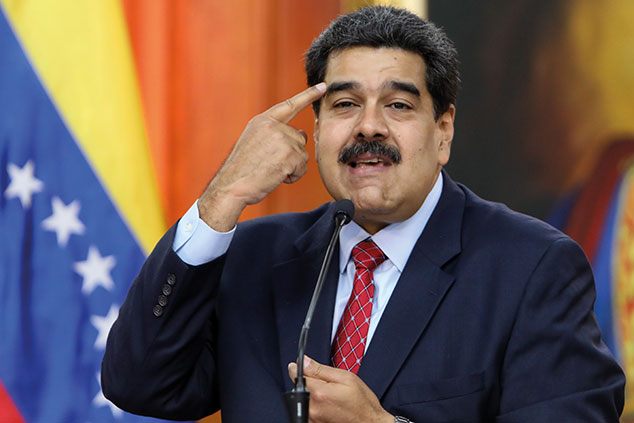
How bad are things in Venezuela?
Bad enough to drive an estimated three million – or one in ten of the population – out of the country over the past four years, in Latin America’s biggest ever mass migration and worst refugee crisis. Venezuela stopped letting in the IMF back in 2004, and no longer publishes economic statistics, so it’s hard to put figures on the scale of the collapse. But most observers think the economy has shrunk by half since 2014, and that Venezuela is now the world’s most indebted country.
The national currency, the bolivar, is worthless. The healthcare system has collapsed and infant mortality has soared. Shop shelves stand empty and there are rolling power cuts. Social order has broken down and violent crime rocketed. People joke grimly about the “Maduro diet” that has left children malnourished, adults thin, and 75% of the population with not enough food.
How did the country get into this mess?
Venezuela’s people are reaping the consequences of years of misconceived economic policies and lavish state spending under Hugo Chávez (president from 1999 until his death in 2013), which were only possible due to the country’s vast oil wealth and the long commodities boom – as well as massive borrowing. There were signs of trouble ahead while Chávez was alive, but after his death in 2013, Venezuela was undone by the oil price crash of 2014-2015.
Venezuela has proved to be an extreme example of the “natural resources curse” – a situation where an abundance of one particular commodity (here, oil) drives out other investment and makes a country’s finances highly vulnerable to a price slump. Matters were made far worse by the incompetence, arrogance, and ideologically driven authoritarianism of Chávez’s hand-picked successor, Nicolas Maduro.
Who was Chávez?
A former army officer, Chávez was a charismatic leftist who was popular with many Venezuelans – especially poorer voters – but whose rule polarised the country. Chávez deployed the country’s windfall from the commodities boom (it enjoys the world’s large reserves of oil) to pursue a “Bolivarian Revolution” – meaning a combination of socialist economics, state-funded largesse, and “anti-imperialist” nationalism.
Under successive Chávez governments, Venezuela nationalised the oil industry, and repaid the faith of Chavistas by bringing in state subsidies for basic goods, exchange and price controls, and state expropriations of private firms – while spewing out vast quantities of rhetoric on the evils of American capitalism.
Did it work?
Of course not. It kept Chávez in power, and kept the show on the road for a time (GDP per person grew steadily during his rule), but it was never sustainable. Foreign investment collapsed, and currency controls hindered imports. Price controls on basic goods inevitably led to shortages (since it was no longer profitable for companies to produce them). Ballooning government deficits led to money-printing and inflation. As things began to turn sour, Chávez veered further to the left, characterising dissenters as the treacherous stooges of Washington or Madrid. But it was not until the crash under Maduro that things unravelled completely.
In the year after he took office, Venezuela’s oil price fell by 50%. State earnings from oil have crashed from $80bn in 2013 (on IMF estimates) to a small fraction of that now, as production has slumped. Even the most gifted and pragmatic politician would have struggled to deal with such a crisis. No-one accuses Maduro of being that.
How has Maduro kept power?
Whereas Chávez convincingly won free and fair elections (at least until his narrow, more questionable win in 2012), Maduro has clung to power through a series of increasingly brazen illegal power grabs. He has seized control of the judiciary and nullified the power of the national assembly. He has sidelined the swelling ranks of Chávez loyalists who have turned against him, imprisoning opponents, and repressing protests.
Crucially, he has also bought the loyalty of the generals. Underlying Maduro’s grip on power are two other factors. First, his position as the heir to Chávez – still regarded with an almost theological devotion by some poorer Venezuelans – means that Chavistas have been slow to turn against him. Second, people are frightened – and desperate to avoid another Caracazo, the wave of riots, protests and massacres in 1989 in which thousands were killed, mostly at the hands of the security forces.
What will happen now?
Regime change at last appears quite likely – a prospect that sent Venezuelan bonds soaring this month. First, there is widespread anecdotal evidence that support for Maduro from his remaining constituency is finally ebbing away. Second, the official start of Maduro’s second term earlier this month stripped away his last vestige of legitimacy, since it follows last year’s sham election.
As a result, the new president of the national assembly, Juan Guaidó, has won the backing of the US, along with most of Latin America, for his claim – in line with Venezuela’s constitution – to be the legitimate interim president pending immediate fresh elections (albeit one with no actual power as yet). The US decision this week to impose punitive sanctions on the state oil company PDVSA has the potential to deal a mortal blow.
Why’s that?
The Caracas government relies on oil for 90% of its revenue, and sends 41% of its oil exports to the US. Furthermore, the US is the only major buyer that pays in cash up front. The bulk of the rest of Venezuelan exports go to China in payment in kind for loans. Under the US sanctions, Washington will block payments to Caracas and instead put the money into accounts that could be transferred to a Guaidó government. This is a big deal for the US: Venezuela is one of its top five suppliers of imported oil. But it is a far bigger deal for Caracas.